|
|
Review of GSM/UMTS-handset Sony Ericsson K610i
Live
photos of Sony Ericsson K610i>>>
Standard kit:
- Handset
- Charger
- Stereo-headset
- 64 Mb Ì2 memory card and adapter
- USB synch cable
- User’s Guide
- CD with software

Video
1 (3GP, 2,41 Mb)>>>
Video
2 (3GP, 833 Kb)>>>
Sony Ericsson decided to bet on promoting line-up of interesting
in terms of design models with high, but not maximal functionality.
Sony Ericsson K600i can be considered as one of such phones, it
should have been a mass solution for UMTS-networks but due to being
overpriced at start it did not. Extreme price drop was answer to
weak demand from consumers in both Europe and Russia. Reasons for
such underrating of handset are due to incorrect positioning of
this model by entering the market, potential audience was scared
away by high price, lack of memory card support, which looked as
essential part for UMTS phone. Unfortunately our prediction that
in short terms this model will cost 250-275 USD were absolutely
correct, this handset became a mass product, which in short-term
perspective gave it good sales but later on it has vanished from
the market as a player with big potential. One of miscalculations
was positioning this model as stylish solution for those who are
not requiring high functionality, but is looking for an interesting
phone that will be used only for phone calls. Smaller popularity
when compared to Nokia’s brand also affected negatively, it did
not allow achieving noticeable results with this model. I’d like
to make a note that operator’s sales due to sales of different color
editions were higher, they can be considered successful.
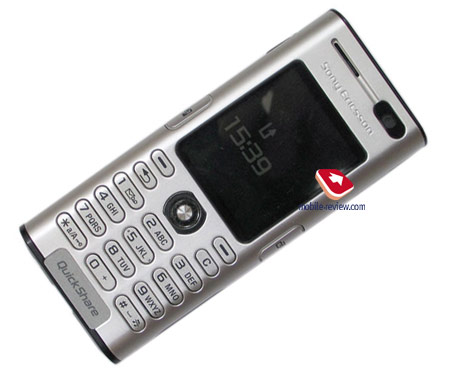
At same time company’s gained experience allowed us to speculate
about possibility of creating middle class model targeted for phone
calls as primary task and additional features such as photos, music
playback as secondary, and so on. This means that company was planning
to introduce a phone that would have a little bit of everything
to the market, and price was supposed to be appealing. In order
to attract bigger audience attention company decided to bet on design
as primary force, another aspect was introducing several color solutions.
This is the way Sony Ericsson K610i (Thelma) was introduced, which
is sort of analogue of Sony Ericsson W710i, but presented in different
form-factor and with support of 3G networks.
When compared to Sony Ericsson K600i new model gained 2mpx camera
w/o autofocus, flash and lens cover. In photo viewing mode Timeline
mode was introduced, you can launch several Java-applications at
once and leave part of them running in the background. At same time
there’s no radio, IrDA. Bluetooth technology is v2.0 from now on
and has EDR, as well as A2DP profile which allows using wireless
headphones bounded with this handset. There are two more buttons
in K610i, one is used for accessing Activity Menu (in K600i this
button was on the side), second button is used for accessing network.
Radio was replaced with music player (K600i had media player), in
case of memory card presence this function turns out being interesting.
This sort of explains why there’s quite modest size of internal
memory, user can use only 16-20mb, depending on the country (in
case with K600 it was 32-40). Manufacturer refused to use Flash
Lite 1.1, instead there’s SVG Tiny 1.1 Finally we should mention
such possibilities as RSS-reader and blgoging. As you can see list
of changes is quite big, and not all of them can be described as
positive. Lack of Radio for example can be counted as shortcoming.
Attempt to attract several focus groups turned out into different
color solutions: Evening Red will attract female users. Model in
red looks extremely interesting and unusual. At same time Urban
Grey looks more common, its strict and laconic at its best. A typical
business solution which it actually is.

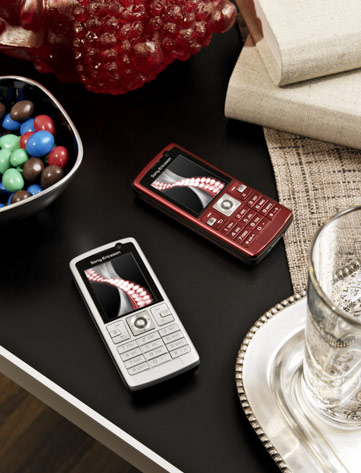
Cellular’s size is compared to Sony Ericsson K750i, handset is
quite small, which will suit many people and this is where it differs
from its elder brothers.



Phone’s size is 102x45.2x16.9 mm, weight – 92 grams. Small weight
became possible with help of using plastic and lack of metallic
elements.

You can recognize a 3G model inside this handset by finding frontal
CIF-camera above the screen, it is used for video calls.

Display is made by TFT technology, earlier on it was a TFD-matrix.
Diagonal was slightly increased, from now on it is 1.9 inches. Resolution
176x220 pixels allows displaying up to 8 text lines and three lines
reserved for service needs (in some modes there can be up to 10
text lines). Display acts normally outdoors, there are no concerns
on that point. This is a typical middle segment solution in terms
of display, such resolutions and specifications are still common
for that one.

The picture on the screen is sharp and full of colors, not perfect
though – Motorola offers several phones boasting more capable displays
on handsets coming from lower price brackets. One more thing of
note is that the screen here reflects up to 262 K colors.
The keypad is made of plastic, and this isn’t a surprise. All buttons
are pretty soft to press and have fair click sensation, in other
words, I had much pleasure of working with them. The soft-keys are
merged into vertical groups and are easy to use as well.


The keys are lit in dim white, which is not always visible, but
provides just enough brightness for all normal environments.

The D-Pad is also soft and immediately reacts to presses – I haven’t
encountered significant flaws in course of a month, which I’ve been
using this handset for, so you can expect it to last much longer
than that.

The left side houses the Music key, standing for media player start
up – in some respects, such solution originates from Walkman-branded
handsets, which the K610i is very similar to, at any rate their
isn’t much of a difference between this device and first generation
of Walkman phones.

Two volume control buttons are placed on the right, as well as
a dedicated camera key. The top rim holds power button and service
indicator, while at the bottom there are Fast Port connector and
holes for a carrying strap.

The rear is not waste either, as there are loudspeaker grill, covered
by a metallic grill, and camera lens with a tiny mirror right next
to it, mounted on the back panel.

The battery cover is not so easy to take off, but owing to this
it exposes no gap. Once the lid is removed, you will see the battery
itself, by the way, M2 memory cards slot is located in this section
as well, even though the feature list contains “hot swap” item.
Apparently, the manufacturer decided that the prospective users
of the K610i wouldn’t switch memory cards frequently and thus no
special slit on the casing was needed. May be, that’s for the best,
considering the target audience of the product.

But enough of guess-work – inside you will find a Li-Pol battery
BST-37 with the capacity of 900 mAh. As the manufacturer claims,
it lasts for 350 hours in standby mode and provides up to 7 hours
of talktime. In conditions of Moscow networks, the handset worked
for two days on average at medium load (nearly one hour of calls,
approximately 30 minutes of games, 20 minutes of Net surfing).

Should you be heavier on using the phone’s functions, recharging
will be required daily. And vice versa – the less you talk the more
the charge is going to last, so at best you will squeeze 3 days
of life time, but it appears almost impossible. Though in European
networks, the phone will last even longer – at least twice as much
owing to better coverage.

Menu
The model lacks 3D accelerator and takes advantage of a standard
API one, mark this point well. The sequencer found on this model
has 72 tones, but makes sense only when playing midi-tracks, in
all other cases it is better to apply mp3 or even eAAC+.
Bluetooth version for this model is 2.0, it supports EDR you can
save improved energy saving mode in the menu. A2DP module is supported,
this allows using wireless stereo headphones. The module itself
(Bluetooth) was reworked, now it has wider capability with 3rd party
devices. Considering the fact that common realization of this technology
by Sony Ericsson is rather good (above average), no major problems
should be encountered.
Standard applications and UI
The interface of the models seems familiar, as it doesn’t differ
from all other Sony Ericsson devices: the main menu has the appearance
of a grid, consisting of 12 icons. Fast number navigation function
is onboard – these shortcuts can be created for the majority of
pre-installed by the manufacturer items on the menu, though this
option is disabled for personal files and applications.

Text input remains on its comfort level, so, pressing the "#"
key brings out a list of the available languages and you can easily
switch between them while typing.
Besides traditional vertical sub-menus, the vendor has provided
thematic horizontal tabs. It means that while viewing a list of
the dialed numbers, one can see not only the dialed numbers but
in the same time (horizontal joystick striking) switch between missed
and received call tabs. In the phone menu this kind of navigation
is provided anywhere it's possible and it makes using the phone
much easier. The menu ergonomics is quite high in this phone model.
I also note that such horizontal panels appear in Phonebook, Settings
and another menu items as well.
Widening of Activity Menu functionality is the result of the fourth
tab addition. The first three ones display various events, like
missed calls, memos, messages – actually all this regards the first
tab. One can disable Activity Menu for these events as well – in
this case pop up windows, reminding of a certain event type will
appear on the screen. The third tab features the shortcuts, which
should you set up yourself. And the added fourth one contains links
to the most frequently used applications and resources – and the
top of this list is claimed by Google search.
The second tab is the most interesting, since it appears to be
some kind of a task manager, featuring the list of all running applications.
The previous handsets by Sony Ericsson supported only multitasking
– you could play a Java-game, listen to the radio or player and
type a message at once. Though these devices made one more step
forward – user is able to run two Java-applications at a time and
switch between them. This may come in handy, in case you use an
ICQ-like mobile client, which should be constantly online, and at
the same time want to play a Java-game. Up to now analogues of these
devices by other manufacturers haven't been announces – however
Nokia is scheduling introduction of this function in its handsets
for the end of 2006 – beginning of 2007. The up-to-date models provide
possibility of simultaneous execution only for standard applications
and one third-party program, and at that they can share the same
network access. Later on they intend to add the capability of running
two third-party applications at once – this function is going to
be incorporated before commercial launch of the devices, as it’s
very attractive and relevant nowadays.
The updated USB-connection function can be rated as innovative
as well – from this point on you’ll have to choose beforehand whether
files on memory card will be accessed or not (data transfer mode).
In the former case, the device shuts down, so you’re able to browse
memory card and in the latter one you are offered various USB settings
for accessing the network – basically the handset transforms into
a modem. As far as I remember similar realization of this function
was featured only in Motorola ROKR E2, where you could use USB Ethernet
(though the main point here and there is the same).
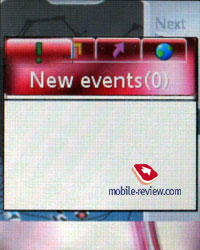
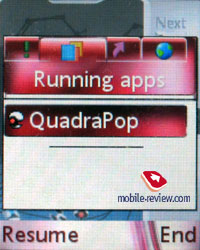
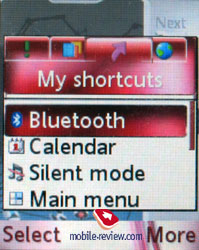
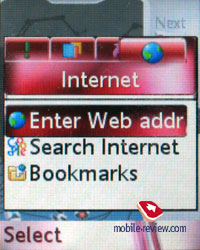
Phonebook. Up to 1000 contacts with fully filled
in fields can be stored in the phonebook, but number of phone numbers
is limited to 2500. This means that despite ability to assign up
to 5 phone numbers to one contact, you cannot go over 2500 entries.
This is enough even for most active users, only few have more than
500 entries in their phonebooks.
Like I mentioned above, several phone numbers can be stored for
one contact, as well as address, email, IM number, other contact
information. In settings you can select the required fields, they
will be available, meanwhile the useless ones will not be present.
Contacts can be sorted by fields, including name and surname, but
only one input field. Unlike previous models, this time we have
dynamic, handset automatically sorts the list after changes.
It is possible to assign custom ringtone and photo for each contact.
During incoming call the image and ringtone will be used. Date of
birth field can be synchronized with Organizer.
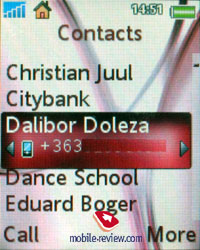
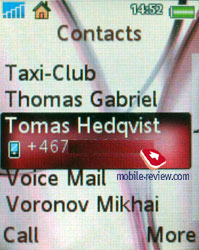
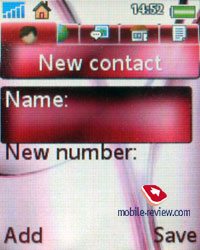
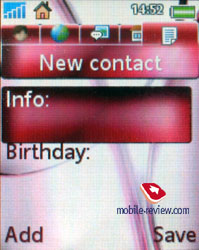
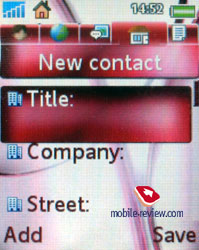
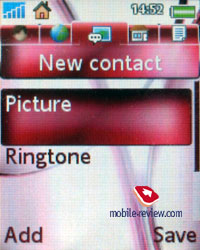
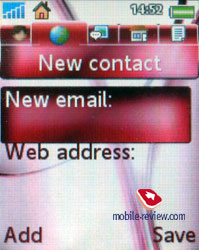
When you are inserting information, you can scroll between tabs,
in the first one you enter phone numbers, their sorting by types.
On the whole the organization of this process reminds of Outlook,
and it means comfort in the first place. Voice tags can be added
for required phone numbers, names, there can be up to 40 of them.
Voice dialing remained the same, it starts looking archaic with
all these voice independent recognition software being implemented
by competitors.
When you are scrolling the contacts, you can try pressing the joystick
to the left or right side to see more information about desired
contact. It’s natural to bind phone number that will be used by
default. From now on Open Contact option is present in the context
menu, it allows viewing the whole contact without going into editing
mode, as it was before.
The company still follows its traditional beliefs that SIM-card
is used in case of emergency, that’s why the only way to see its
contents is to go to special option in the menu. SIM contacts are
not displayed in phonebook.
You can create back-up copy of all entries from phonebook, it will
be stored on the memory card, so you will have the ability to restore
them afterwards.
Contact Groups are required only for mass SMS sending, since it
is impossible to bind custom ringtone or photo for Group.
Messaging. All possibilities for operations with
messages are standard, there are templates and possibilities to
create your own. Phone’s memory together with SIM-card is used for
storing messages. Chat function is supported. On the whole everything
is just like in any other phone from this company. Only emoticons
icons were changed, they became more interesting.
The MMS realization is great as always, you can literally create
video clips, there are lots of settings and this is one of those
things that gives SE’s product parity over competitors.
E-Mail client can send and receive emails, all sort of encodings
are supported. The emails can be stored to memory card.
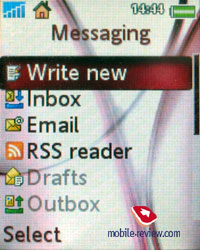
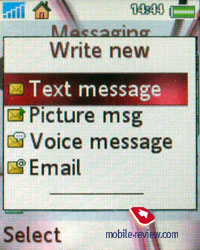
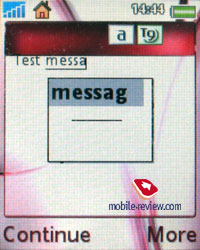
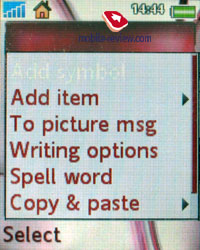
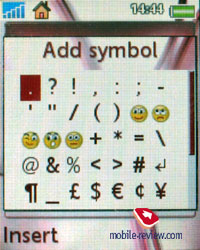
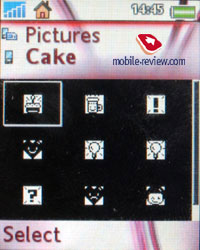
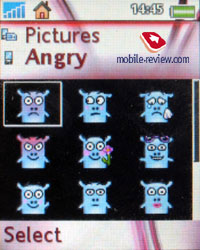
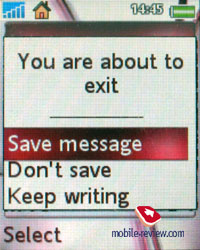
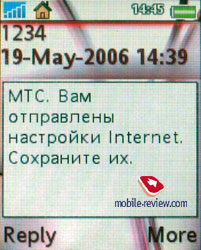
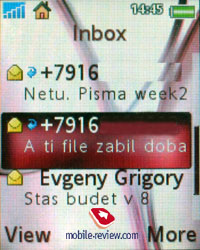
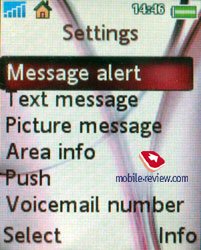
In email settings you can setup separate password for SMTP-accounts,
this is very convenient. Settings are flexible, support of almost
all encodings, and not only Unicode was added. Attachments that
are supported by the phone are presented as icons in email body.
The phone is not working with office files or PDF, but they can
be stored in any directory. The limit for outgoing/incoming email
size is set by operator. Emails with 6-7mb attachments can be sent
without any problems. The phone supports Push Mail standard. Naturally
send & receive process are done in background mode.
RSS Feed. The settings are extremely simple, you
jus specify the title for feed and its address. The phone will connect
and download it. You can update only one item, or the whole feed
at once. Possibilities of built-in browser are used for displaying
the feeds.
Call list. Up to 30 records can be stored in common
list, all with date and time. Icon that stands for call type (missed/received/dialed)
is shown next to every entry. Besides this additional icon identifies
if this phone number is present in the phone book or SIM-card. The
list of missed calls can be seen separately, it stores up to 10
entries. In this menu you can also see the cost calls, length of
all cals, outgoing calls and last call. Tabs are present, this saves
some time.
Entertainment. Photos, music files can be accessed
from this menu. MusicDJ function is rather interesting,
even though it is a niche product and there is not much of a chance
that this feature will be in high demand by users. In the editor
you can create and edit ring tones, up to four tracks.
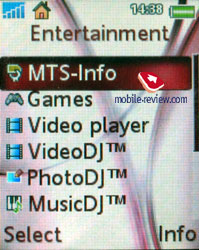
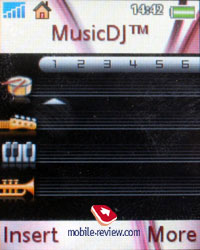
Advanced version of MusicDJ is called VideoDJ, it allows
editing not only music files, but also adding images and signs.
The final result is presented in 3GP file which can be sent by MMS
or Email, or just transferred to another phone.
The creative ones can use graphical editor PhotoDJ, you can draw
simple images. Sometimes time flies when you’re having fun with
PhotoDJ, but most of the time this feature is just useless.
Remote control – ability to control other devices
via Bluetooth connection. It is standard for all phones by SE.

The sound can be recorded by Dictaphone, it allows
making voice tags that can be later used as ring tones. Phone calls
can be recorded too, this is done from context menu there is no
time limit.
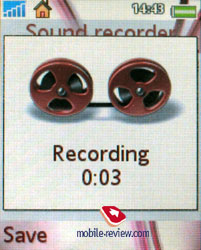
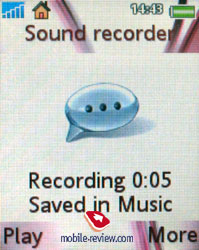
Games – the phone contains only one game - QuadraPop.
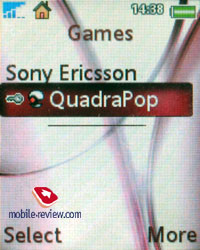
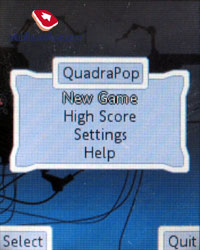
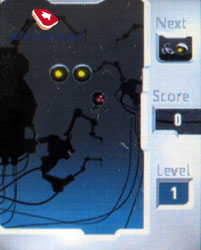
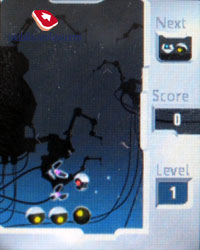
Organizer. Organizer keeps a lot of function underneath.
Let’s review Calendar in the first place. There are three types
for viewing the events: weekly, monthly or today. In last option
you will see list of all events and memos, in two others you will
see highlighted time or day. You can switch to required day and
year, or month. Everything is pretty standard, as well as schedule
input. You get the chance to name the event, define the place where
it will be held, length and setup the reminder (beforetime or right
at the start of the event). For the first time events can be reoccurred.
Types of reoccurrence: daily, monthly. Reminders work even if the
phone is turned off, unless you disable this function.
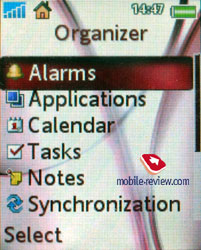
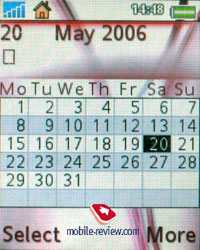
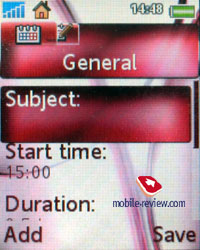
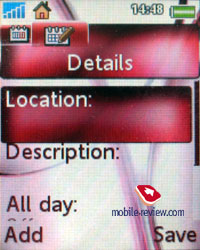
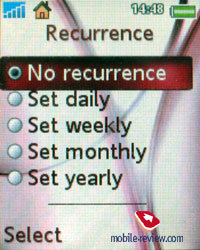
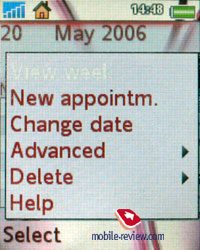
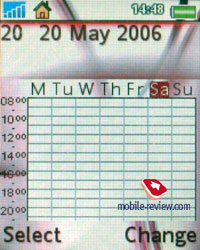
To do list in this phone is quite ascetic. There are only
two types of events: phone call or reminder. On the other hand,
this is really enough, simplicity has its advantages.
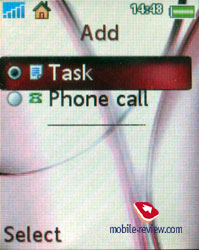
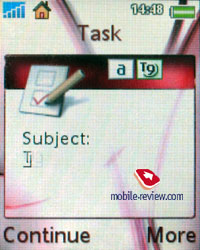
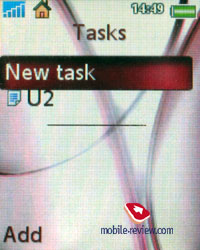
The phone has full-fledged search, organized for calendar: you
specify the search line (word or part of it) and after a while you
will see all events that would match this criteria. The function
works rather fast even if the organizer has more than 100 entries,
fast switch to the event from the search window is supported.
The phone features normal transfer of schedule to various devices
(traditionally via IrDA and Bluetooth). Choose the required interval
(day, week or month) and send all entries. I’d like to point out
that the device should support PIM function in order to open and
display this data properly. It is possible to send the schedule
to TV-set through IrDA connection, the TV-set accepts it but is
unable to display the received goods. Data can be received the same
way, with the help of desktop or office PC without any additional
software.
Notes. The phone supports notes entry, though they are
limited by length. The name of the note will be first word entered.
This is not always convenient since you will have to use first word
that would automatically tell you what the note is about.
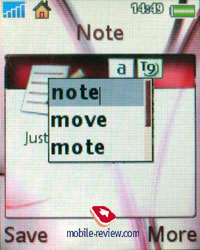
Alarm Clock. We’ve got changes in this one, now you have
five alarm clocks, and each of them can be set up separately. They
can trigger on definite week days. Besides the ringtone for alarm
clock you can selet small note and picture, they will be displayed
when alarm clock goes on. Any music file or radio can be seleted
as the alarm itself.
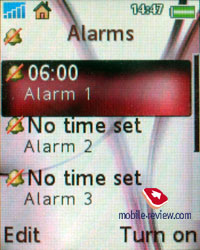
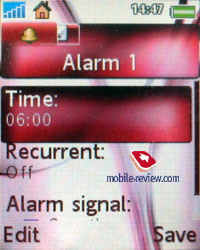
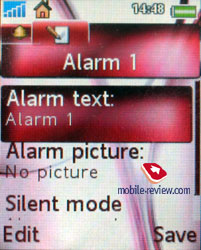
Stopwatch/Countdown. Here everything is quite standard,
although the same can be said about the stopwatch, that has temporary
value function. The phone has special application for storing secret
codes, which was a great hit in previous models, well, standard
calculator is present too.
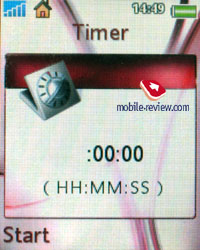
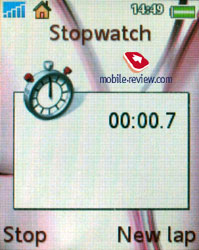
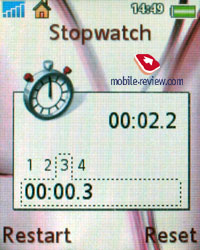
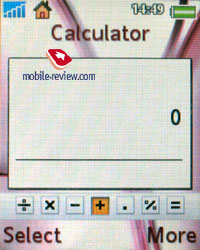
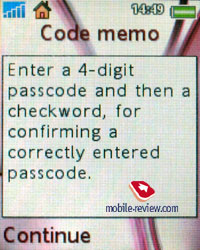
World Time function is inside.
Connectivity. All communicative settings for the
phone can be setup from here, starting from WAP and GPRS and ending
up with Bluetooth and Synchronization. I will not describe the standard
options, they are standard in the first place, and everything there
works fine. I’d like to highlight stable Bluetooth work, no problems
were encountered, synchronization with other devices runs smoothly,
all profiles (including A2DP, which is stereo sound via Bluetooth)
are supported. Bluetooth version is 2.0 with EDR support.
Local and Remote synchronization can be setup from the same menu.
The phone supports HID profile which allows using it as Remote control
for PC and other devices.
The following Bluetooth profiles are supported:
- Dial-up networking profile
- Generic Access profile
- Generic Object Exchange Profile
- Object Push Profile
- Serial Port Profile
- Handsfree Profile
- Headset Profile
- Synchronization Profile
- Basic Imaging Profile
- File Transfer Profile
- HID Profile
- SyncML OBEX binding
- JSR-82 Java API
- A2DP
WAP. The browser owns separate menu item, the
version is 2.0, it supports secured connections which is quite important
in case you are using electronic transactions. New wallpapers, themes
and ring tones can be downloaded right away, it’s all available
at the original web-site.
Standard browser for Sony Ericsson phones is NetFront, it supports
one-line web-page display and HTML. One of the convenient parts
is ability to create folders with files, bookmarks. The browser
is considered as one of the best on the market, but limited phone
resources does not make its usage into one easy process. On the
whole those who are using Internet constantly should consider buying
PDA or laptop, since full Internet access is not in such high demand
for this device class. At the same time RSS Feeds support is great,
it allows using the phone for reading news, announcements and materials.
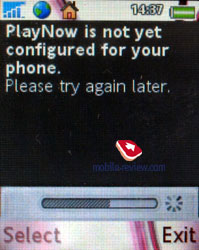
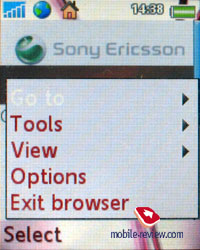
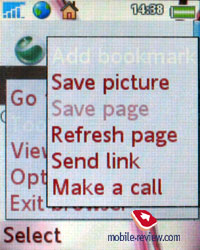
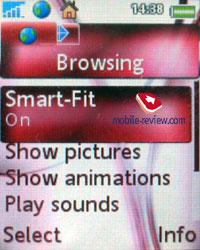
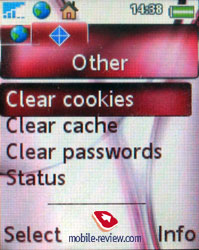
HTML pages that content advanced formatting or overcome 500kb in
their size will not be displayed. On the whole standard browser
is optimal, but usage of Opera Mini is preferable, it has more opportunities.
Settings. This menu stores all settings related
to phone’s work and partly with its outlook. In the stand by mode
clock can be displayed in the bottom (yes or no), you an also choose
the font size, in case you select big letters it will be easy to
see what time it is, but the font itself becomes transparent. There
isn’t anything to add, all the rest is standard.
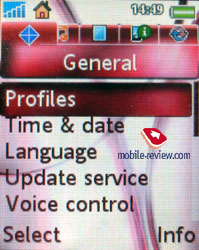
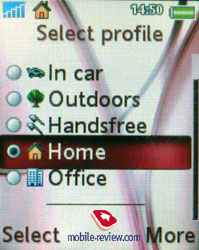
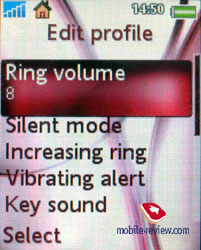
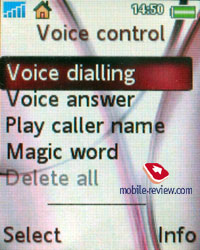
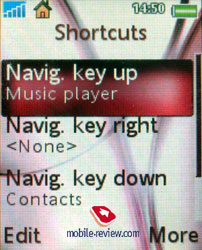
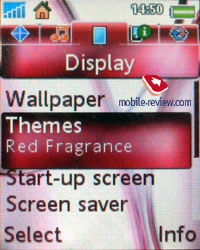
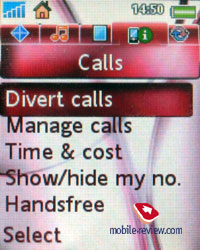
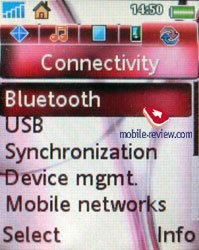
File manager, memory size. The user has 16 MB
of available memory add empty M2 memory card to that too. Here all
data (photos, videos, applications) can be stored. The remaining
memory is occupied by preinstalled applications, you cannot delete
them. Part of memory is dedicated to phonebook, call lists, etc.
The phone has simplest file manager, with its help files can be
sorted by various folders, custom directories can be created in
phone’s memory, files can be moved there as well. With or without
cable the phone can become a perfect storage, there are no problems
with recording your own files, even if they cannot be opened by
the phone.
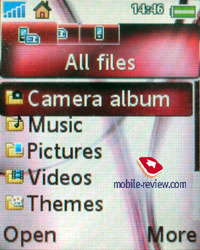
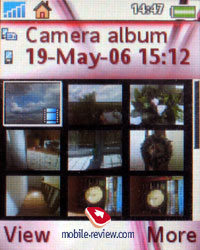
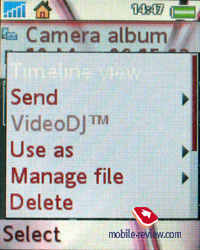
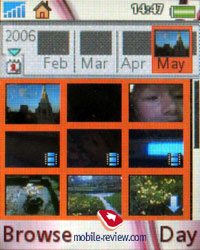
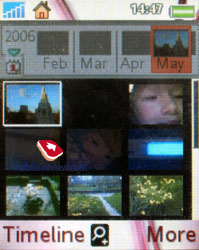

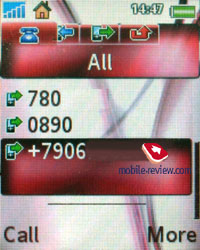
Traditional file sorting includes the following options: date,
type and size. The Image Gallery has new setting called Timeline,
after you activate it you will see a bar on which months will be
shown. And in lists you will see photos that were made during this
or that month. You can make the list more detailed by pressing the
same key twice, in that case you will see days instead of months,
meaning that photos will be sorted in the following structure: list
of images made on October 3rd, for example. This is a good way to
wander around tons of images.
Player. The phone has built-in mp3 (AAC, eAAC+,
WMA formats are also supported), 3GP and mpeg4 player. It is a good
way to listen to mp3 files. Besides settings you can setup equalizer
(there are predefined settings: Bass, Voice, Tremble, etc), as well
as the ability to create your custom ones. The sound changes according
to the settings, this is noticeable.
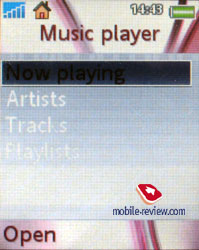
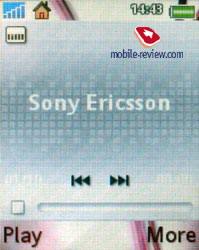
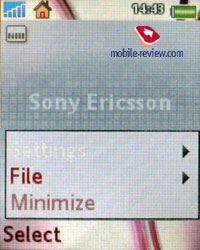
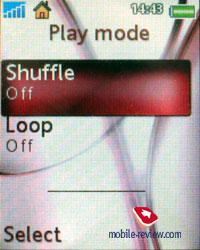
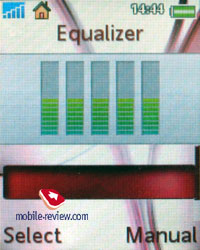
The player is similar to the one Sony Ericsson W800i, it replicates
it maximally. It is possible to minimize the player, the phone supports
multi-function at full scale. There are no concerns at all here,
as the player found on the K610i is a good solution from the class
the handset originates from.
Camera. The device is equipped with a 2 MP camera
with a CMOS matrix without auto-focus.
The device supports three possible resolutions - 1632x1224, 640x480,
160x120 pixels. Two types of data compression, Normal and Fine,
are at your disposal. The majority of the photos represented are
in the Fine quality. The photos differ in size almost two times
depending on the resolution. Thus a photo in the Normal mode takes
about 300 KB when the Fine quality gives 500-600 KB. Saving the
photo takes the same time not depending on the case, that is about
1-2 seconds
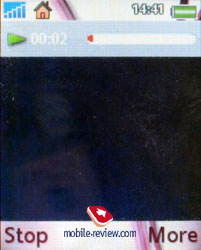
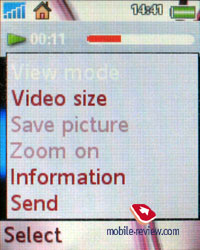
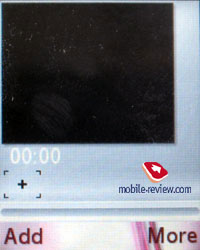
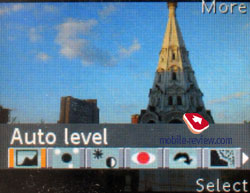
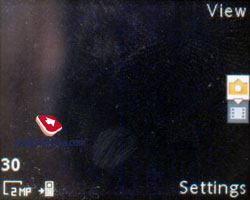
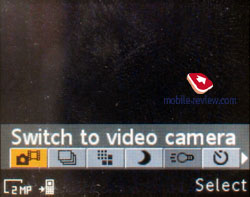
The camera settings look the following way:
- Shutter sound. You can choose on of the three shutter sounds
but not turn the sound off.
- White balance. A possibility to choose between an automatic
mode or Incandescent, Fluorescent, Daylight.
- Effects. Several effects may be applied to the photos, they
are Negative, Solarize, Sepia, Black & White.
- Timer is activated for a certain time period for self shooting.
- Night mode is for shooting in the dark. Noises raise on a photo,
exposition is increased (you shouldn't move the device in order
not to get a blurry photo).
- Shooting mode. Normal mode, that is taking usual photos. A
multiple mode (Burst 4) allows taking four photos for a series.
Landscape is a very interesting mode that allows taking rather
unordinary photos, has no rivals for the moment. The last mode
is taking photos with frames, photo resolution decreases automatically.
The screen serves as a viewfinder when in the shooting mode. The
picture moves very smoothly and everything is clearly seen. Number
keys help in switching between various functions and shooting parameters
quickly that fastens work greatly.
Picture samples: Sony Ericsson K610i –on the left, Sony Ericsson
K750i –on the right
 |
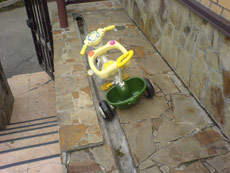 |
(+)
maximize, 1600x1200 |
(+)
maximize, 1632x1224 |
 |
 |
(+)
maximize, 1600x1200 |
(+)
maximize, 1632x1224 |
 |
 |
(+)
maximize, 1600x1200 |
(+)
maximize, 1632x1224 |
 |
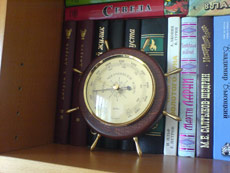 |
(+)
maximize, 1600x1200 |
(+)
maximize, 1632x1224 |
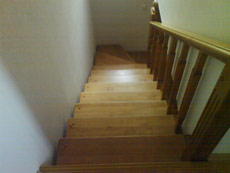 |
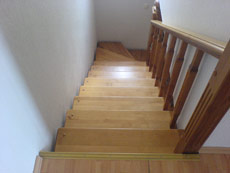 |
(+)
maximize, 1600x1200 |
(+)
maximize, 1632x1224 |
 |
 |
(+)
maximize, 1600x1200 |
(+)
maximize, 1632x1224 |
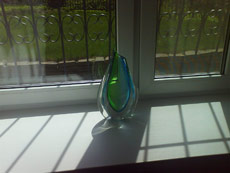 |
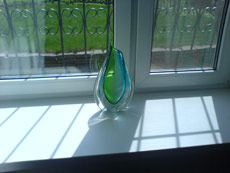 |
(+)
maximize, 1600x1200 |
(+)
maximize, 1632x1224 |
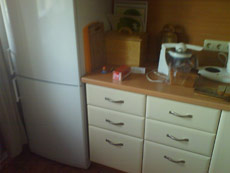 |
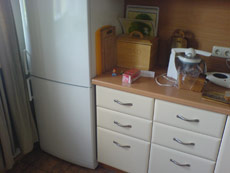 |
(+)
maximize, 1600x1200 |
(+)
maximize, 1632x1224 |
 |
 |
(+)
maximize, 1600x1200 |
(+)
maximize, 1632x1224 |
 |
 |
(+)
maximize, 1600x1200 |
(+)
maximize, 1632x1224 |
Video may be recorded in two resolutions (176x144, 128x96), file
format is 3GP. Clip duration may be limited (up to 10 seconds) or
unlimited. The quality of the clips is average and obviously inferior
to many top models.
Video
sample (3GP, 282 Kb)>>>
Video
sample 2 (3GP, 200 Kb)>>>
Video
sample3 (3GP, 101 Kb)>>>
Impressions
Despite the polyphony being 72-tone, the handset does not provide
a breakthrough in sounding of mp3 tunes as compared to other Sony
Ericsson branded phones. The loudspeaker is average volume-wise
and has a great part of basses in its sounding, so the call is easily
heard even on the street. The silent alarm is of moderate power
or even slightly higher than this, but even this admission isn’t
an excuse for cases when it is too weak to be felt. The receiving
part is on the same level as that of other products by the company
– in other words, it’s very fine.
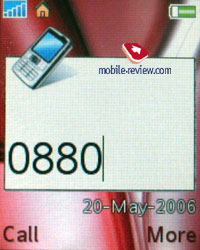
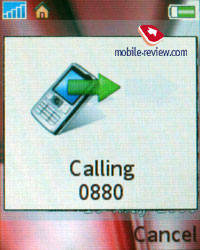
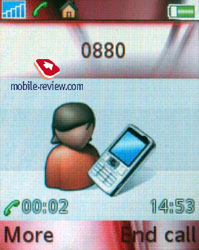
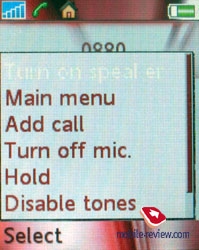
Sony Ericsson K610i is scheduled to begin shipping at the end of
July and due to the model coming from the middle price-bracket,
its price will vary from 240 to 260 Euro. Against the background
of other upcoming Sony Ericsson proposals, like Sony Ericsson W710i,
Z710i, this handset may get blended with the mass of available phones
and become something like a makeshift. Nevertheless, reasoning from
amount of posts featuring this model, one might justly state that
it would have its own audience and stable sale rates. It won’t become
a bestseller for sure, yet it isn’t destined for that, unlike the
K600i, the main aim of this device is widening the product range
– and that’s where it really does great.
The K610i is appealing owing to its capability of working with
a number of applications simultaneously; on top of that the music
front reports a success, though you will still need to buy good
headphones. The rest of the handset’s functionality doesn’t have
any obvious pros or cons – it is rather a typical up-to-date offering
by Sony Ericsson. One more peculiarity – availability of red trim,
which is extremely rare on the market nowadays, despite the fact
majority of girls like it.
Eldar Murtazin (eldar@mobile-review.com)
Translated by Alexandr "Lexx" Zavoloka
(alexander.zavoloka@mobile-review.com),
Oleg Kononosov (oleg.kononosov@mobile-review.com)
Published — 22 June 2006
Have something to add?! Write us... eldar@mobile-review.com
|
News:
[ 31-07 16:21 ]Sir Jony Ive: Apple Isn't In It For The Money
[ 31-07 13:34 ]Video: Nokia Designer Interviews
[ 31-07 13:10 ]RIM To Layoff 3,000 More Employees
[ 30-07 20:59 ]Video: iPhone 5 Housing Shown Off
[ 30-07 19:12 ]Android Fortunes Decline In U.S.
[ 25-07 16:18 ]Why Apple Is Suing Samsung?
[ 25-07 15:53 ]A Few Choice Quotes About Apple ... By Samsung
[ 23-07 20:25 ]Russian iOS Hacker Calls It A Day
[ 23-07 17:40 ]Video: It's Still Not Out, But Galaxy Note 10.1 Gets An Ad
[ 19-07 19:10 ]Another Loss For Nokia: $1 Billion Down In Q2
[ 19-07 17:22 ]British Judge Orders Apple To Run Ads Saying Samsung Did Not Copy Them
[ 19-07 16:57 ]iPhone 5 To Feature Nano-SIM Cards
[ 18-07 14:20 ]What The iPad Could Have Looked Like ...
[ 18-07 13:25 ]App Store Hack Is Still Going Strong Despite Apple's Best Efforts
[ 13-07 12:34 ]Infographic: The (Hypothetical) Sale Of RIM
[ 13-07 11:10 ]Video: iPhone Hacker Makes In-App Purchases Free
[ 12-07 19:50 ]iPhone 5 Images Leak Again
[ 12-07 17:51 ]Android Takes 50%+ Of U.S. And Europe
[ 11-07 16:02 ]Apple Involved In 60% Of Patent Suits
[ 11-07 13:14 ]Video: Kindle Fire Gets A Jelly Bean
Subscribe
|





























































































































